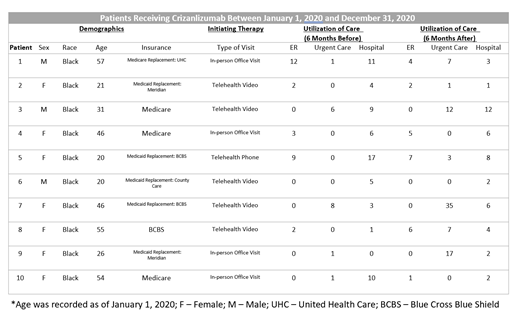Abstract
Background
Sickle cell disease (SCD) is a hemoglobinopathy which manifests clinically as hemolytic anemia and recurrent episodes of pain caused by vaso-occlusion, among other symptoms. Vaso-occlusive crises (VOCs) account for an overwhelming majority of visits to the emergency room (ER) and hospitalizations for patients with SCD (Shah et al. PLoS One 2019). Upregulation of P-selectin, a cellular adhesion protein expressed on activated platelets and endothelial cells, contributes to the pathophysiology of VOCs. Crizanlizumab is a monoclonal antibody administered intravenously that inhibits the interaction of P-selectin with its ligand; it was approved by the Food and Drug Administration (FDA) as a treatment for SCD patients in 2019. In the Phase II SUSTAIN trial, crizanlizumab therapy resulted in a significantly lower rate of sickle cell-related pain crises than placebo (Ataga et al. N Engl J Med 2017).
Due to their high-risk status for COVID-19, the pandemic has posed significant challenges for SCD patients to readily access healthcare, including novel therapies such as crizanlizumab. This study aimed to investigate the utility of telemedicine in facilitating access to crizanlizumab as well as compare acute medical care utilization for patients on crizanlizumab six months before initiating therapy and up to six months after their final dose in 2020.
Methods
All patients (≥18 years of age as of January 1, 2020) with SCD who received crizanlizumab between January 1, 2020 and December 31, 2020 at Rush University Medical Center (RUMC) were included in the final analysis. Demographic features as well as the type of visit when the patient and healthcare provider discussed crizanlizumab treatment was documented. Paired t-tests and Wilcoxon matched-pairs signed rank tests were utilized to compare acute medical care utilization - defined by the number of ER visits, urgent care visits, and hospitalizations - six months prior to initiating therapy and six months after completing the specified therapy regimen for 2020. Simple linear regression models and multiple regression models were conducted to control for sex, BMI, age, insurance, duration of treatment, and type of visit.
Results
A total of ten patients were included in the final analysis. Five (50%) patients first agreed to proceed with crizanlizumab therapy during a telehealth video visit with their provider, one (10%) made the decision during a telehealth phone visit, and the other four (40%) did so during a traditional office visit. 9 (90%) patients were still on crizanlizumab after June 1, 2020, the date that RUMC urgent care started seeing patients with SCD. The mean number of visits to the ER in the period before initiating therapy was 2.8 (SD=4.26) compared to 2.5 (SD=2.76) after last dose in 2020, however this finding did not achieve statistical significance (p>0.9999). Visits to the urgent care clinic, on average, increased significantly from 1.7 (SD=2.87) in the six months before initiating therapy to 8.2 (SD=11.02) in the six months after ending therapy for 2020 (p=0.0234). The mean number of hospitalizations in the period before initiating therapy was 6.6 (SD=5.19) compared to 4.6 (SD=3.44) in the period after last dose in 2020, however this was also not statistically significant (p=0.2309). None of the covariates had a significant effect on differences in acute care utilization in the period before and after therapy in 2020.
Conclusion
This study suggests that administration of crizanlizumab therapy did reduce hospitalization and ED visits, but the results could not achieve statistical significance due to our small sample size and short study duration. The number of urgent care visits for these patients, however, did differ significantly from the period before initiating therapy to the six months after the last dose in 2020. This finding can be attributed to the fact that due to the COVID-19 pandemic, urgent care services were made increasingly available to SCD patients beginning on June 1, 2020 to avoid admissions to the ER and hospital. Additionally, our study suggests that during the COVID-19 pandemic, telemedicine played an important role in providing health services to patients with SCD, and it could continue to improve care accessibility for SCD patients after the pandemic. Continued collection and analysis of real-world data is needed to further understand the effect of crizanlizumab therapy on utilization of acute medical care.
Jain: DOVA: Other: advisory board; Sanofi: Other: advisory board; Argenx: Other: advisory board; Novartis: Speakers Bureau; GBT: Speakers Bureau.


This feature is available to Subscribers Only
Sign In or Create an Account Close Modal